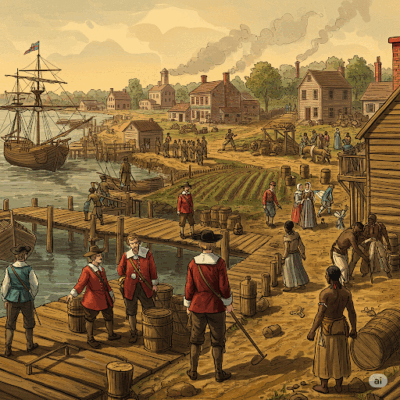The Early American Colonies: Different Paths in a New World
Most Americans today see the thirteen original colonies as the unified beginning of our nation. However, these settlements developed with striking differences despite their geographical proximity along the eastern seaboard. The New England colonies (founded by Puritans and other religious groups) and the Chesapeake Bay colonies (established primarily for profit) represent the most dramatic contrast. Their development followed different trajectories shaped by religion, government, family structure, economics, and geography.
Religious Foundations
The New England colonies began with spiritual purpose. Pilgrims and Puritans crossed the Atlantic seeking religious freedom and the opportunity to build communities centered on their faith. In contrast, Chesapeake settlers primarily sought economic opportunity and advancement.
This fundamental difference shaped daily life. New England communities typically gathered around shared religious practices, with church serving as both spiritual and community center. Religion influenced education too, with New England establishing schools to ensure children could read the Bible.
In the Chesapeake region, though church attendance was often required, it functioned more as a social control mechanism than spiritual practice. The tobacco-based plantation economy physically separated neighbors, making religious gatherings less central to community life.
Governing Structures
Both regions technically answered to the English Crown, but developed distinct local governance. In New England, democracy took root early. The Mayflower Compact, signed before the Pilgrims even disembarked, established government by consent of the governed. Town meetings became common, allowing broad participation in local decisions.
The Chesapeake colonies maintained more traditional European power structures. Wealthy landowners dominated political life, creating a system that preserved economic hierarchies. This reflected their economic organization around large plantations rather than towns.
New England governments often focused on community welfare and moral regulation, while Chesapeake governance centered on maintaining property rights and tax collection. These different approaches reflected their distinct values and priorities.
Family Life
Family structures profoundly influenced colonial development. New England settlers typically arrived as family units, creating stable communities from the start. The harsh climate and religious values encouraged tight-knit households where parents raised children with strict moral instruction.
Chesapeake colonies initially had few women and children, with most early settlers being single men. This created communities with weaker family traditions. High mortality rates due to disease further disrupted family formation. When families did develop, they often followed European patterns of patriarchal authority rather than the more community-oriented New England model.
Economic Systems
Geography shaped dramatically different economies. The Chesapeake region’s climate proved perfect for tobacco cultivation, leading to a plantation system dependent on labor-intensive agriculture. Initially using indentured servants and later enslaved Africans, these colonies developed an export economy dominated by large landowners.
New England’s rocky soil and shorter growing season made large-scale agriculture impractical. Instead, colonists developed diverse economic activities:
- Small family farms producing for local consumption
- Fishing industries utilizing abundant coastal resources
- Shipbuilding using the region’s timber
- Trading networks that eventually reached global markets
This economic diversity fostered more equal wealth distribution and urbanization, with bustling port cities developing earlier than in the plantation-dominated south.
Geographical Influence
The physical landscape profoundly shaped colonial development. Chesapeake’s warm climate and navigable waterways supported plantation agriculture but also harbored diseases that contributed to high mortality rates. New England’s harsher climate limited agricultural options but provided abundant natural resources like timber, fish, and fur-bearing animals.
Settlement patterns reflected these differences. New England typically developed compact towns centered around churches and meeting houses. Chesapeake settlements spread across the landscape, with plantations serving as self-contained economic and social units connected primarily by waterways.
Legacy and Significance
These regional differences eventually contributed to the strength of the emerging American nation. When the colonies united against British rule, they brought complementary strengths to the revolutionary effort:
- New England’s democratic traditions and community organization
- The Chesapeake region’s agricultural production and wealthy leadership class
- Shared experiences with self-governance and adaptation to New World conditions
The American experiment succeeded partly because it incorporated these diverse colonial traditions rather than imposing uniformity. Our federal system still reflects this balance between unity and regional diversity that began in these early settlements.
Understanding these colonial differences helps us appreciate how geography, economics, and human values interact to shape societies. While we’ve become one nation, regional distinctions that began in colonial times continue to influence American culture today.
